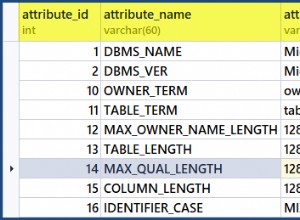Aggiorna :Dopo un'ulteriore analisi e dispiegamento di > ALL di MySQL strana implementazione. Questa risposta dovrebbe essere considerata specifica per MySQL. Quindi, per ulteriore disclaimer, spiegazione sulla risposta qui relativa a > ALL non è applicabile ad altri RDBMS (a meno che non ci siano altri RDBMS che hanno copiato l'implementazione di MySQL). Traduzione interna da > ALL a un MAX costrutto, si applica solo a MySQL.
Questo:
select id from t1 where id > all (select id from t2);
è semanticamente equivalente a:
select id from t1 where id > (select max(id) from t2);
Poiché select max(id) from t2 restituisce 1, la seconda query si materializza in questo:
select id from t1 where id > 1
Ecco perché restituisce entrambi 10 e 2 dalla tabella t1
Uno dei casi in cui vengono applicate le regole NULL è quando usi NOT IN , un esempio:
DDL:
create table t1(id int);
insert into t1 values (10),(2);
create table t2(id int);
insert into t2 values (0),(null),(1);
Domanda:
select * from t1 where id not in (select id from t2);
-- above is evaluated same as the following query, so the rules about null applies,
-- hence the above and following query will not return any record.
select * from t1 where id <> 0 and id <> null and id <> 1;
-- to eliminate null side-effect, do this:
select * from t1 where id not in (select id from t2 where id is not null);
-- which is equivalent to this:
select * from t1 where id <> 0 and id <> 1;
Le ultime due query restituiscono 10 e 2 , mentre le prime due query restituiscono un insieme vuoto
Test dal vivo:http://www.sqlfiddle.com/#!2/82865/ 1
Spero che questi esempi cancellino la tua confusione con le regole NULL.
Riguardo a
Sql ottimizzato essendo questo:
select `test`.`t1`.`id` AS `id` from `test`.`t1` where <not>((`
test`.`t1`.`id` <= (select max(`test`.`t2`.`id`) from `test`.`t2`)))
Questo è davvero equivalente alla tua query originale:select id from t1 where id > all (select id from t2);
Il costrutto t1.field > all (select t2.field from t2) è solo uno zucchero sintattico per:
t1.field > (select max(t2.field) from t2)
Se applicherai il teorema di DeMorgan sull'SQL ottimizzato di MySql:
not (t1.id <= (select max(t2.id) from t2))
Ciò equivale a:
t1.id > (select max(t2.id) from t2)
Che a sua volta è equivalente allo zucchero sintattico ALL :
t1.id > ALL(select t2.id from t2)




